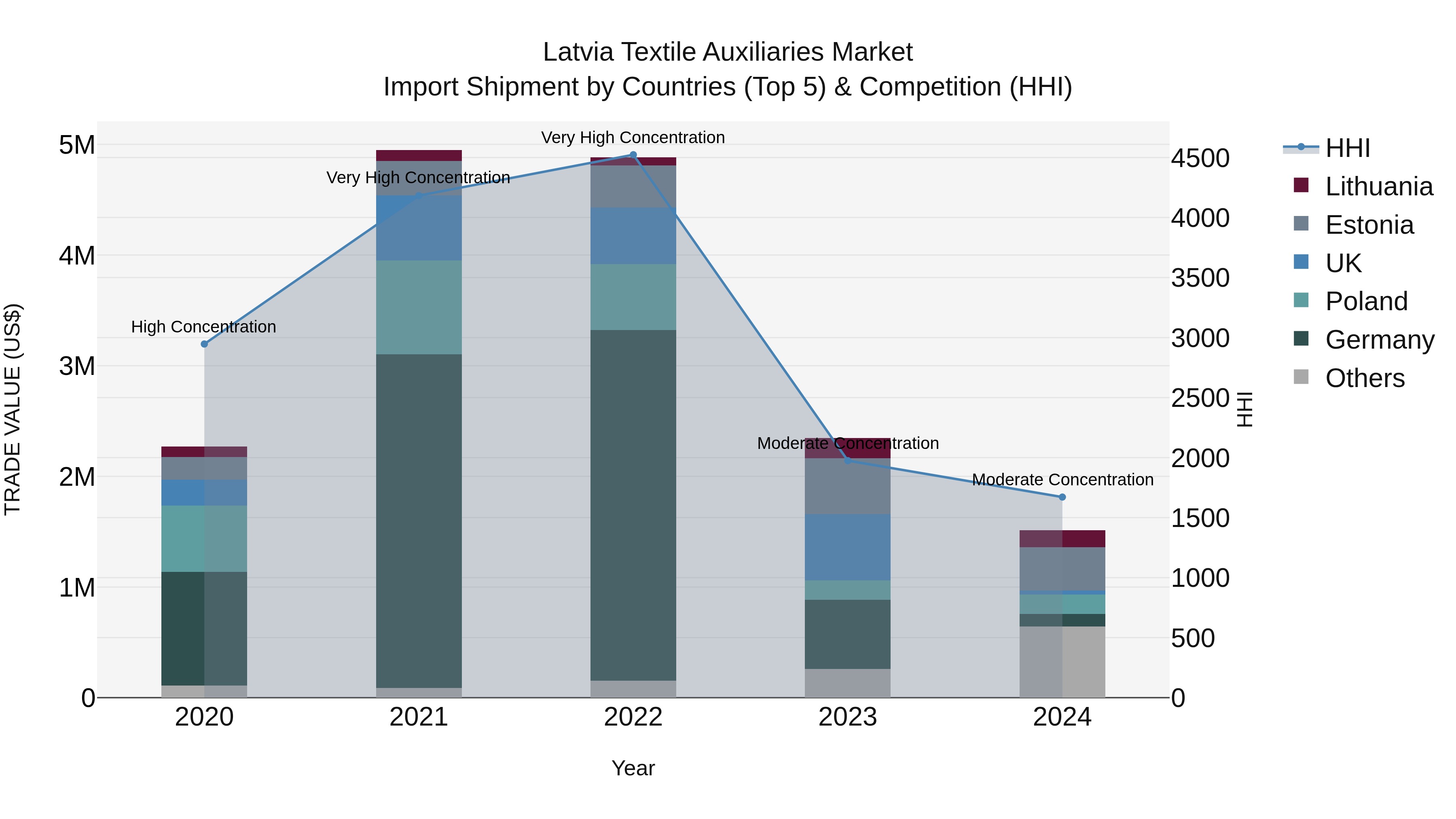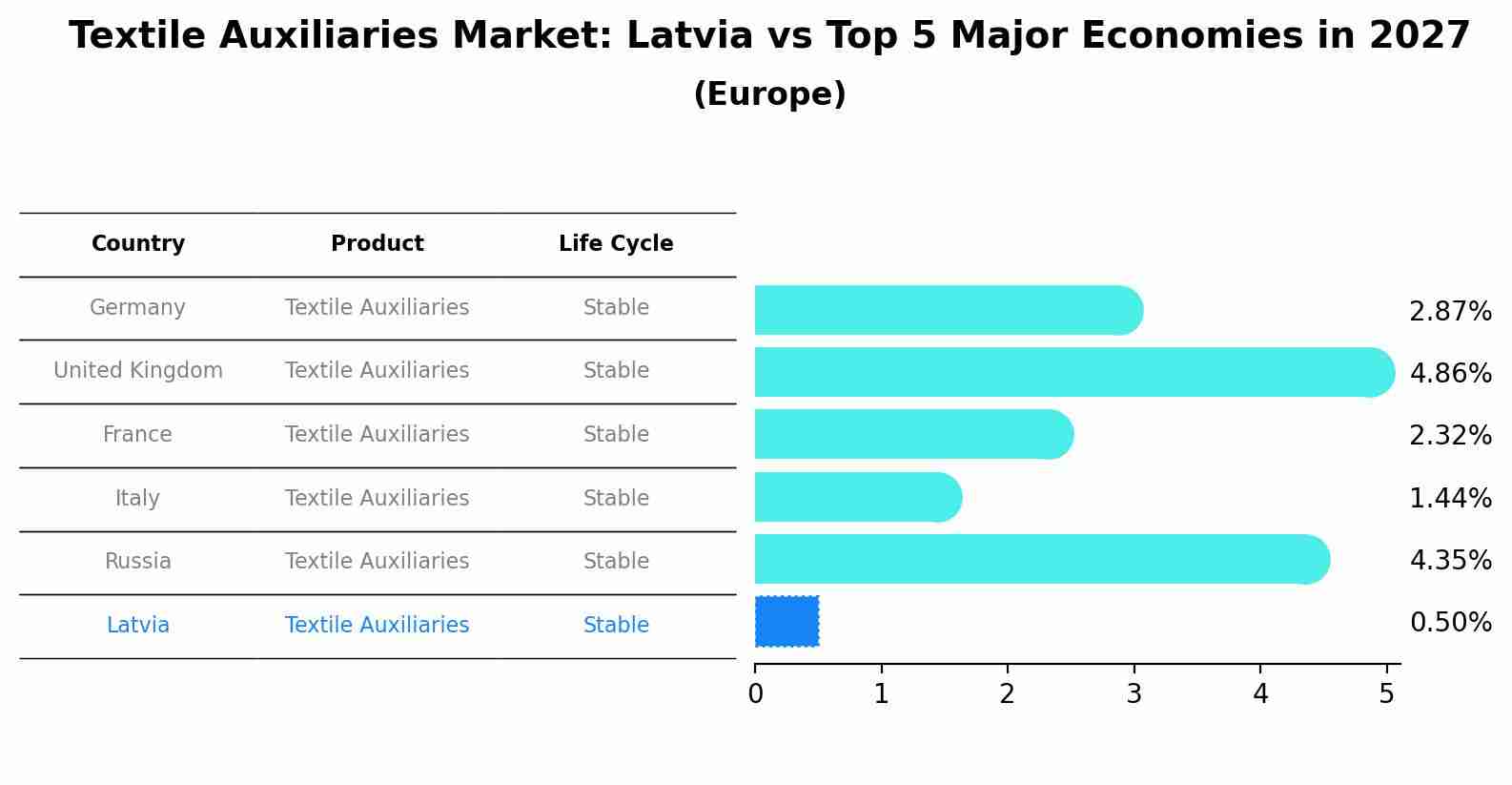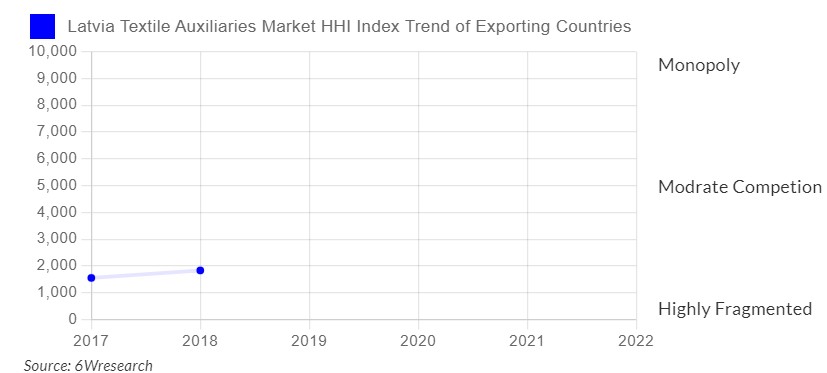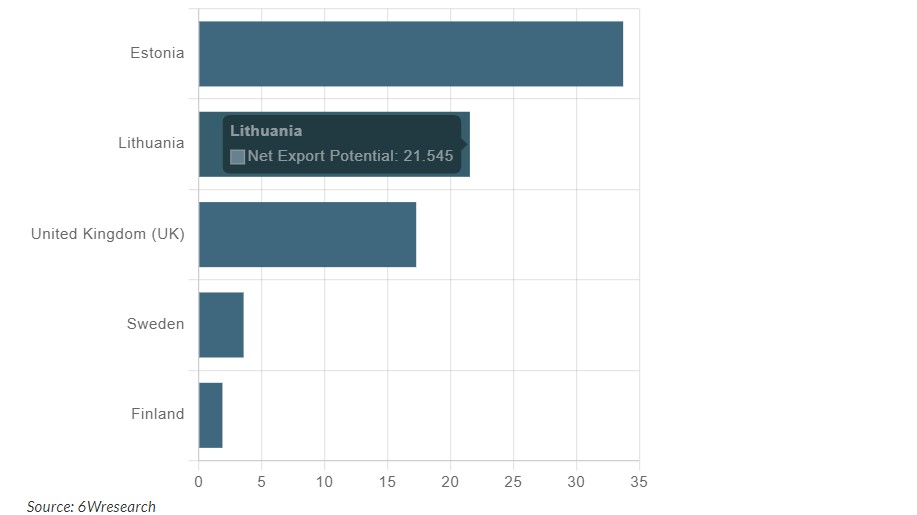Latvia Textile Auxiliaries Market (2024-2030) | Outlook, Growth, Size, Companies, Share, Analysis, Trends, Forecast, Value, Segmentation, Revenue & Industry
Market Forecast By Product (Finishing Agents, Dyeing and Printing Agents, Spin Finish, Knitting and Weaving, Other Auxiliaries), By Applications (Automotive Textiles, Home Furnishing, Apparel, Digital Printing, Others) And Competitive Landscape
| Product Code: ETC4715968 | Publication Date: Nov 2023 | Updated Date: Nov 2025 | Product Type: Market Research Report | |
| Publisher: 6Wresearch | Author: Shubham Padhi | No. of Pages: 60 | No. of Figures: 30 | No. of Tables: 5 |
Latvia Textile Auxiliaries Market Top 5 Importing Countries and Market Competition (HHI) Analysis
Latvia`s textile auxiliaries import market in 2024 saw a diverse range of suppliers, with Estonia, Metropolitan France, Spain, Poland, and Lithuania emerging as the top exporting countries. Despite a moderate concentration level measured by the HHI, the market experienced a significant decline in both the CAGR and growth rate from 2020 to 2024, indicating challenges and changes in the industry dynamics. Stakeholders should closely monitor these trends and adapt their strategies to navigate the evolving landscape effectively.

Textile Auxiliaries Market: Latvia vs Top 5 Major Economies in 2027 (Europe)
In the Europe region, the Textile Auxiliaries market in Latvia is projected to expand at a stable growth rate of 0.50% by 2027. The largest economy is Germany, followed by United Kingdom, France, Italy and Russia.

Latvia Textile Auxiliaries Market Competition 2023

Note: Herfindahl–Hirschman index (HHI Index) helps in measuring the competition in the nation. HHI which is lower than 1500 signifies high competitiveness, 1500-2500 shows moderate competition and 2500-6000 means concentrated and more than 6000 means highly concentrated.
Latvia Textile Auxiliaries market, in 2023, witnessed an HHI of 1832, Which has augmented moderately as compared to the HHI of 0 in 2017. This significant rise in numbers shows that the market is moving towards moderately competitive. The herfindahl index measures the competitiveness of exporting countries and the range lies from 0 to 10000, where a lower index number represents a larger number of players or exporting countries in the market while a large index number means fewer numbers of players or countries exporting in the market.
Latvia Export Potential Assessment For Textile Auxiliaries Market (USD Values in Thousand)

Note: Export potential is calculated by considering trade relations, duties, distance, tariffs, total import demand, as well as GDP growth projection from IMF World Economic Outlook
Estonia seems to be the potential market for For Latvia Exporters of Textile Auxiliaries (in 2028) in terms of export capability followed by Lithuania, the United Kingdom (UK), Sweden and Finland. Based on total import demand across all countries, the United Kingdom (UK) occupies the top position. Hence considering overall import demand, the United Kingdom (UK) leads the importing demand but considering Latvia as a partner, Estonia delivers high unmet demand potential in comparison to others for 2028.
Key Highlights of the Report:
- Latvia Textile Auxiliaries Market Outlook
- Market Size of Latvia Textile Auxiliaries Market, 2023
- Forecast of Latvia Textile Auxiliaries Market, 2030
- Historical Data and Forecast of Latvia Textile Auxiliaries Revenues & Volume for the Period 2020-2030
- Latvia Textile Auxiliaries Market Trend Evolution
- Latvia Textile Auxiliaries Market Drivers and Challenges
- Latvia Textile Auxiliaries Price Trends
- Latvia Textile Auxiliaries Porter`s Five Forces
- Latvia Textile Auxiliaries Industry Life Cycle
- Historical Data and Forecast of Latvia Textile Auxiliaries Market Revenues & Volume By Product for the Period 2020-2030
- Historical Data and Forecast of Latvia Textile Auxiliaries Market Revenues & Volume By Finishing Agents for the Period 2020-2030
- Historical Data and Forecast of Latvia Textile Auxiliaries Market Revenues & Volume By Dyeing and Printing Agents for the Period 2020-2030
- Historical Data and Forecast of Latvia Textile Auxiliaries Market Revenues & Volume By Spin Finish for the Period 2020-2030
- Historical Data and Forecast of Latvia Textile Auxiliaries Market Revenues & Volume By Knitting and Weaving for the Period 2020-2030
- Historical Data and Forecast of Latvia Textile Auxiliaries Market Revenues & Volume By Other Auxiliaries for the Period 2020-2030
- Historical Data and Forecast of Latvia Textile Auxiliaries Market Revenues & Volume By Applications for the Period 2020-2030
- Historical Data and Forecast of Latvia Textile Auxiliaries Market Revenues & Volume By Automotive Textiles for the Period 2020-2030
- Historical Data and Forecast of Latvia Textile Auxiliaries Market Revenues & Volume By Home Furnishing for the Period 2020-2030
- Historical Data and Forecast of Latvia Textile Auxiliaries Market Revenues & Volume By Apparel for the Period 2020-2030
- Historical Data and Forecast of Latvia Textile Auxiliaries Market Revenues & Volume By Digital Printing for the Period 2020-2030
- Historical Data and Forecast of Latvia Textile Auxiliaries Market Revenues & Volume By Others for the Period 2020-2030
- Latvia Textile Auxiliaries Import Export Trade Statistics
- Market Opportunity Assessment By Product
- Market Opportunity Assessment By Applications
- Latvia Textile Auxiliaries Top Companies Market Share
- Latvia Textile Auxiliaries Competitive Benchmarking By Technical and Operational Parameters
- Latvia Textile Auxiliaries Company Profiles
- Latvia Textile Auxiliaries Key Strategic Recommendations
Frequently Asked Questions About the Market Study (FAQs):
13 Disclaimer
|
1 Executive Summary |
|
2 Introduction |
|
2.1 Key Highlights of the Report |
|
2.2 Report Description |
|
2.3 Market Scope & Segmentation |
|
2.4 Research Methodology |
|
2.5 Assumptions |
|
3 Latvia Textile Auxiliaries Market Overview |
|
3.1 Latvia Country Macro Economic Indicators |
|
3.2 Latvia Textile Auxiliaries Market Revenues & Volume, 2020 & 2030F |
|
3.3 Latvia Textile Auxiliaries Market - Industry Life Cycle |
|
3.4 Latvia Textile Auxiliaries Market - Porter's Five Forces |
|
3.5 Latvia Textile Auxiliaries Market Revenues & Volume Share, By Product, 2020 & 2030F |
|
3.6 Latvia Textile Auxiliaries Market Revenues & Volume Share, By Applications, 2020 & 2030F |
|
4 Latvia Textile Auxiliaries Market Dynamics |
|
4.1 Impact Analysis |
|
4.2 Market Drivers |
|
4.2.1 Growing demand for eco-friendly and sustainable textile auxiliaries |
|
4.2.2 Increasing focus on innovation and product development in the textile industry |
|
4.2.3 Favorable government policies supporting the textile sector in Latvia |
|
4.3 Market Restraints |
|
4.3.1 Fluctuating raw material prices affecting the cost of production |
|
4.3.2 Intense competition from global textile auxiliaries manufacturers |
|
4.3.3 Regulations and compliance requirements regarding the use of certain chemicals in textile processing |
|
5 Latvia Textile Auxiliaries Market Trends |
|
6 Latvia Textile Auxiliaries Market Segmentations |
|
6.1 Latvia Textile Auxiliaries Market, By Product |
|
6.1.1 Overview and Analysis |
|
6.1.2 Latvia Textile Auxiliaries Market Revenues & Volume, By Finishing Agents, 2020-2030F |
|
6.1.3 Latvia Textile Auxiliaries Market Revenues & Volume, By Dyeing and Printing Agents, 2020-2030F |
|
6.1.4 Latvia Textile Auxiliaries Market Revenues & Volume, By Spin Finish, 2020-2030F |
|
6.1.5 Latvia Textile Auxiliaries Market Revenues & Volume, By Knitting and Weaving, 2020-2030F |
|
6.1.6 Latvia Textile Auxiliaries Market Revenues & Volume, By Other Auxiliaries, 2020-2030F |
|
6.2 Latvia Textile Auxiliaries Market, By Applications |
|
6.2.1 Overview and Analysis |
|
6.2.2 Latvia Textile Auxiliaries Market Revenues & Volume, By Automotive Textiles, 2020-2030F |
|
6.2.3 Latvia Textile Auxiliaries Market Revenues & Volume, By Home Furnishing, 2020-2030F |
|
6.2.4 Latvia Textile Auxiliaries Market Revenues & Volume, By Apparel, 2020-2030F |
|
6.2.5 Latvia Textile Auxiliaries Market Revenues & Volume, By Digital Printing, 2020-2030F |
|
6.2.6 Latvia Textile Auxiliaries Market Revenues & Volume, By Others, 2020-2030F |
|
7 Latvia Textile Auxiliaries Market Import-Export Trade Statistics |
|
7.1 Latvia Textile Auxiliaries Market Export to Major Countries |
|
7.2 Latvia Textile Auxiliaries Market Imports from Major Countries |
|
8 Latvia Textile Auxiliaries Market Key Performance Indicators |
8.1 Percentage of revenue from new eco-friendly product lines |
8.2 Research and development expenditure as a percentage of total revenue |
8.3 Number of government initiatives supporting the textile industry in Latvia |
8.4 Customer satisfaction index for textile auxiliaries |
8.5 Percentage of market share in specific textile segments (excluding overall market share) |
|
9 Latvia Textile Auxiliaries Market - Opportunity Assessment |
|
9.1 Latvia Textile Auxiliaries Market Opportunity Assessment, By Product, 2020 & 2030F |
|
9.2 Latvia Textile Auxiliaries Market Opportunity Assessment, By Applications, 2020 & 2030F |
|
10 Latvia Textile Auxiliaries Market - Competitive Landscape |
|
10.1 Latvia Textile Auxiliaries Market Revenue Share, By Companies, 2023 |
|
10.2 Latvia Textile Auxiliaries Market Competitive Benchmarking, By Operating and Technical Parameters |
|
11 Company Profiles |
|
12 Recommendations |
- Single User License$ 1,995
- Department License$ 2,400
- Site License$ 3,120
- Global License$ 3,795
Search
Thought Leadership and Analyst Meet
Our Clients
Related Reports
- Canada Oil and Gas Market (2026-2032) | Share, Segmentation, Value, Industry, Trends, Forecast, Analysis, Size & Revenue, Growth, Competitive Landscape, Outlook, Companies
- Germany Breakfast Food Market (2026-2032) | Industry, Share, Growth, Size, Companies, Value, Analysis, Revenue, Trends, Forecast & Outlook
- Australia Briquette Market (2025-2031) | Growth, Size, Revenue, Forecast, Analysis, Trends, Value, Share, Industry & Companies
- Vietnam System Integrator Market (2025-2031) | Size, Companies, Analysis, Industry, Value, Forecast, Growth, Trends, Revenue & Share
- ASEAN and Thailand Brain Health Supplements Market (2025-2031) | Strategy, Consumer Insights, Analysis, Investment Trends, Opportunities, Growth, Size, Share, Industry, Revenue, Segments, Value, Segmentation, Supply, Forecast, Restraints, Outlook, Competition, Drivers, Trends, Demand, Pricing Analysis, Competitive, Strategic Insights, Companies, Challenges
- ASEAN Bearings Market (2025-2031) | Strategy, Consumer Insights, Analysis, Investment Trends, Opportunities, Growth, Size, Share, Industry, Revenue, Segments, Value, Segmentation, Supply, Forecast, Restraints, Outlook, Competition, Drivers, Trends, Demand, Pricing Analysis, Competitive, Strategic Insights, Companies, Challenges
- Europe Flooring Market (2025-2031) | Outlook, Share, Industry, Trends, Forecast, Companies, Revenue, Size, Analysis, Growth & Value
- Saudi Arabia Manlift Market (2025-2031) | Outlook, Size, Growth, Trends, Companies, Industry, Revenue, Value, Share, Forecast & Analysis
- Uganda Excavator, Crane, and Wheel Loaders Market (2025-2031) | Strategy, Consumer Insights, Analysis, Investment Trends, Opportunities, Growth, Size, Share, Industry, Revenue, Segments, Value, Segmentation, Supply, Forecast, Restraints, Outlook, Competition, Drivers, Trends, Demand, Pricing Analysis, Competitive, Strategic Insights, Companies, Challenges
- Rwanda Excavator, Crane, and Wheel Loaders Market (2025-2031) | Strategy, Consumer Insights, Analysis, Investment Trends, Opportunities, Growth, Size, Share, Industry, Revenue, Segments, Value, Segmentation, Supply, Forecast, Restraints, Outlook, Competition, Drivers, Trends, Demand, Pricing Analysis, Competitive, Strategic Insights, Companies, Challenges
Industry Events and Analyst Meet
Whitepaper
- Middle East & Africa Commercial Security Market Click here to view more.
- Middle East & Africa Fire Safety Systems & Equipment Market Click here to view more.
- GCC Drone Market Click here to view more.
- Middle East Lighting Fixture Market Click here to view more.
- GCC Physical & Perimeter Security Market Click here to view more.
6WResearch In News
- Doha a strategic location for EV manufacturing hub: IPA Qatar
- Demand for luxury TVs surging in the GCC, says Samsung
- Empowering Growth: The Thriving Journey of Bangladesh’s Cable Industry
- Demand for luxury TVs surging in the GCC, says Samsung
- Video call with a traditional healer? Once unthinkable, it’s now common in South Africa
- Intelligent Buildings To Smooth GCC’s Path To Net Zero


















